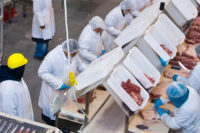
The protein-processing industry has come a long way over the decades in the realm of food safety, and much of that advancement can be attributed to the standardization and research involved in the sanitation process.
The use of proper sanitation practices, tools and equipment can often be the difference between a facility producing a safe, clean product or a product that might hit the headlines as a recalled item. Proper sanitation also can ensure that equipment will perform as it should for its anticipated life (and possibly longer), without wearing down or degrading because of dirt, grime and food waste on its surfaces and in its niches.
Proper sanitation starts with a company Sanitation Standard Operating Procedures (SSOP), which describes, as stated in a Minnesota Department of Agriculture fact sheet1 on the topic, “the activities the processor performs before they start to process food each day. It also describes steps taken during operations that the processor uses to prevent direct product contamination. These written procedures need to be specific and must contain many details of a processor’s sanitation program.”
Part of a processor’s SSOP should detail the specific sanitizers that the sanitation workers must use, as well as the process by which each machine should be cleaned. There are a variety of work surfaces and shapes that workers must cover, and to ensure definitive cleanliness, these procedures need to be written down in the SSOP.
When it comes to sanitizers, however, one should not overlook the importance of water, according to Ronald H. Schmidt, Ph. D., professor and food science extension specialist, Food Science and Human Nutrition Department, Cooperative Extension Service, Institute of Food and Agricultural Sciences, University of Florida.
Schmidt, in an extension document titled “Basic Elements of Equipment Cleaning and Sanitizing in Food Processing and Handling Operations,”2 says water comprises 95 to 99 percent of cleaning and sanitizing solutions. It functions specifically as a carrier ” it brings the sanitizer to the surface in need of cleaning, and then carries the soils or contaminants away from the surface after the sanitizer has removed them.
Schmidt warns that the water used for cleaning must be potable and pathogen-free, and that processors may need to treat water before using it for sanitation purposes in a meat plant. He advises also that processors must be aware of the effects that water hardness can have on sanitizers and the surfaces that they are cleaning.
“Water hardness is the most important chemical property with a direct effect on cleaning and sanitizing efficiency,” he writes. Other impurities, he adds, can affect the food contact surface or may affect the soil deposit properties or film formation.
Endnotes
1 “Basic Facts about SSOP’s and HACCP Plans for Meat Processors” by the Minnesota Department of Agriculture.
http://www.mda.state.mn.us/news/publications/licensing/meat&egg/haccpssopbasics.pdf
2 “Basic Elements of Equipment Cleaning and Sanitizing in Food Processing and Handling Operations” by Ronald H. Schmidt, Ph. D., professor and food science extension specialist, Food Science and Human Nutrition Department, Cooperative Extension Service, Institute of Food and Agricultural Sciences, University of Florida.
http://edis.ifas.ufl.edu/pdffiles/FS/FS07700.pdf








